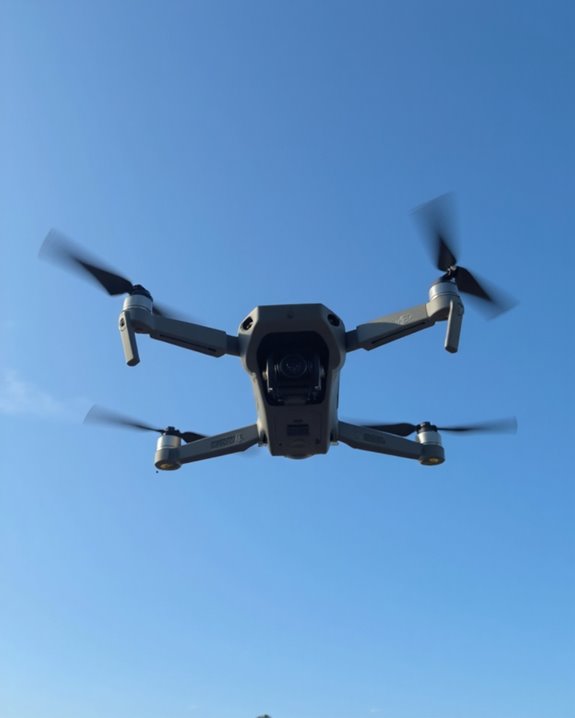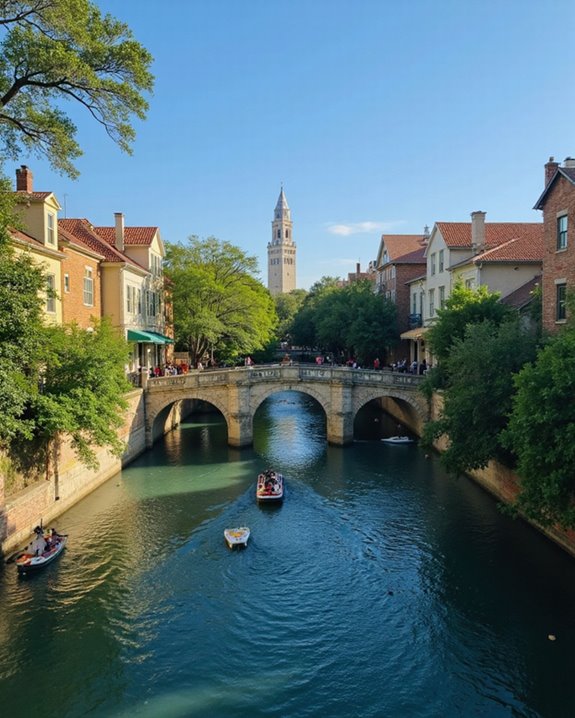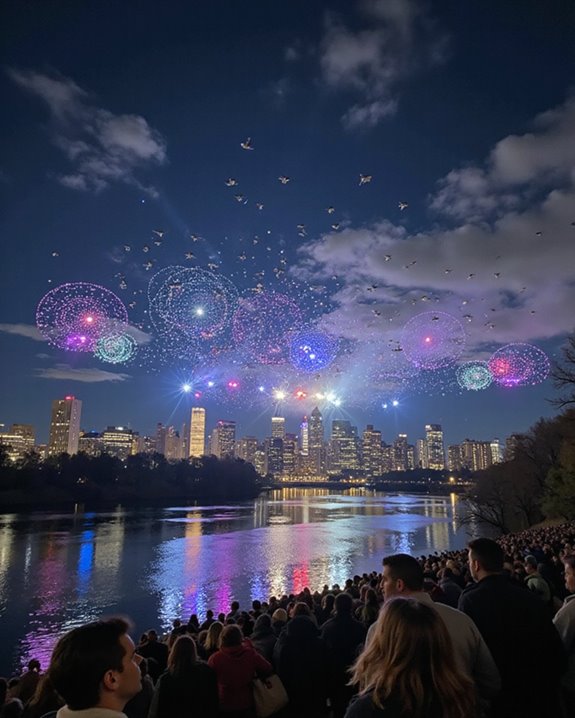The first drone shows didn’t just appear out of nowhere—imagine early hot air balloons and radio-controlled crafts blazing the trail, while engineers dreamed of sky-high choreographed magic! Austria’s SPAXELS dazzled crowds in 2012, setting the standard for future events, like Intel’s enormous 2,066-drone performance at the Winter Olympics. Tech breakthroughs, LED lights, and clever programming turned flying robots into a global spectacle. Curious how these mind-blowing displays keep audiences safe and inspired around the world? Stay tuned!
Key Takeaways
- The origins of unmanned flight date back to 1783 with the Montgolfier brothers’ hot air balloon and evolved through military and photographic uses in the 1800s.
- The concept of drone shows emerged from inspirations like fireworks and light parades, enabled by advances in battery life and control systems.
- The world’s first large-scale drone light show, SPAXELS by Ars Electronica Futurelab, debuted in Austria in 2012, marking a new entertainment era.
- Technological breakthroughs—such as GPS-guided autonomous flight, LED lighting, and synchronized software—made complex aerial choreography with drones possible.
- Safety measures, legal compliance, and industry standards became essential as drone shows expanded globally for public events and cultural celebrations.
Early Roots of Unmanned Flight
The story of unmanned flight didn’t just pop out of thin air—believe it or not, it actually began way back in 1783! The famous balloon pioneers, Joseph-Michel and Jacques-Étienne Montgolfier, sent a hot air balloon soaring skyward with no pilot on board, marking the true flight origins of unmanned aircraft. You might imagine early inventors dreaming of robots, but their balloons simply floated on heated air, setting a sky-high precedent. By 1849, balloons were used in battle, acting as unmanned scouts. Then, in 1858, the first aerial photo was snapped from aloft, proving unmanned vehicles could do more than just drift. These clever innovations, from floating cameras to radio-controlled crafts, quietly paved the way for everything we call “drones” today!
Birth of the Drone Display Concept
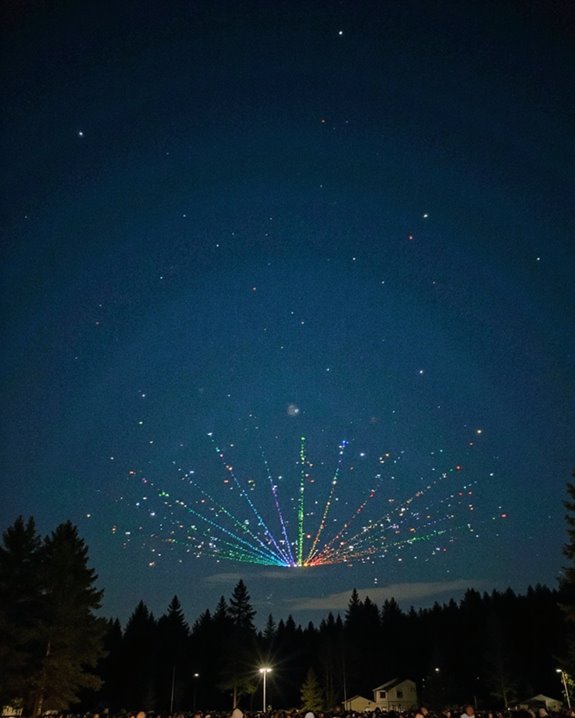
Ever wondered how a sky full of glowing drones became the newest way to wow a crowd? The birth of the drone display concept didn’t just happen overnight; it borrowed Inspiration Sources from classics like fireworks and light parades, but added a futuristic twist! As tech improved, especially with longer battery life and smarter controls, the idea moved from “cool dream” to “let’s try this.” Artistic expression joined the party, turning hundreds—or even thousands—of drones into a canvas for synchronized visuals. Viability Factors were key: organizers had to check if crowds loved these shows and if costs made sense. Safety was never an afterthought; every performance needed precise controls and careful planning. Suddenly, the night sky wasn’t just for stars anymore! The use of LED strobe lights on drones has become essential for enhancing visibility and creating striking night displays.
Technological Breakthroughs and Milestones
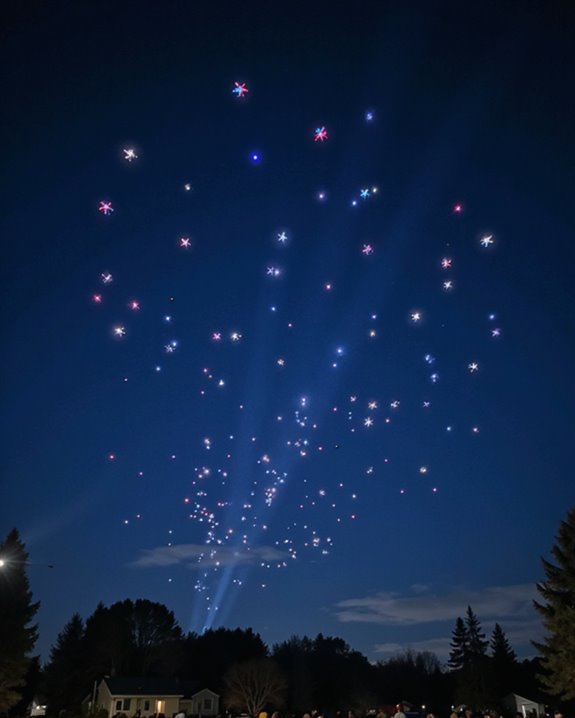
Imagine this: a single drone buzzing overhead in the early 1900s, guided by clunky radio controls that Nikola Tesla himself could only dream about, and now—fast-forward to stadiums filled with thousands of glowing lights dancing in perfect harmony! Technological breakthroughs have changed everything. Early models struggled with Battery Longevity, barely making it through a rehearsal, but today’s drones soar for entire performances thanks to improved batteries and lightweight frame materials like carbon fiber. Radio control gave way to autonomous flight and GPS integration, letting drones zip into perfect formations. LED technology brought vibrant color, and software integration made complex choreography possible. Miniaturization made drones safer, and inter-drone communication allowed for dazzling, synchronized displays. All this—plus real-time data and safety protocols—has made drone shows jaw-droppingly spectacular! Modern drones also benefit from extended flight times reaching up to 102 minutes, enabling longer and more intricate shows.
Expanding Horizons: From Art to Global Events
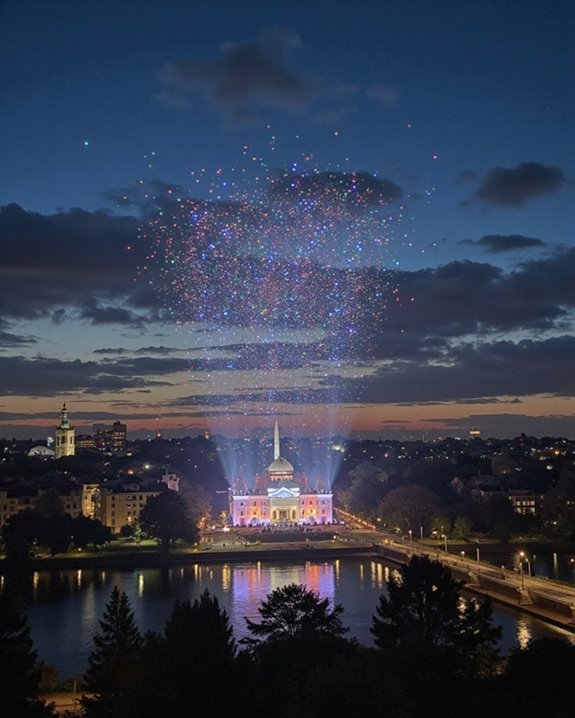
While it might sound like something out of a sci-fi movie, drone shows have quickly soared far beyond their early roots, dazzling audiences from art galleries to Olympic stadiums. The first big leap happened in 2012, when Ars Electronica Futurelab’s “SPAXELS” lit up the Austrian sky, introducing the world to Cultural Blends of technology and art. Before long, drones were dancing above the Winter Olympics, breaking records and wowing millions. From Newcastle’s SKYMAGIC displays to Intel’s 2,066-drone spectacle, Public Engagements became a major draw, bringing communities together in awe. Drone shows adapted for festivals in Asia, New Year’s bashes on Al Marjan Island, and celebrations everywhere. Today, these flying lights blend tradition and innovation, proving that art, tech, and a little fun really can travel the globe!
Navigating Safety and Regulatory Challenges
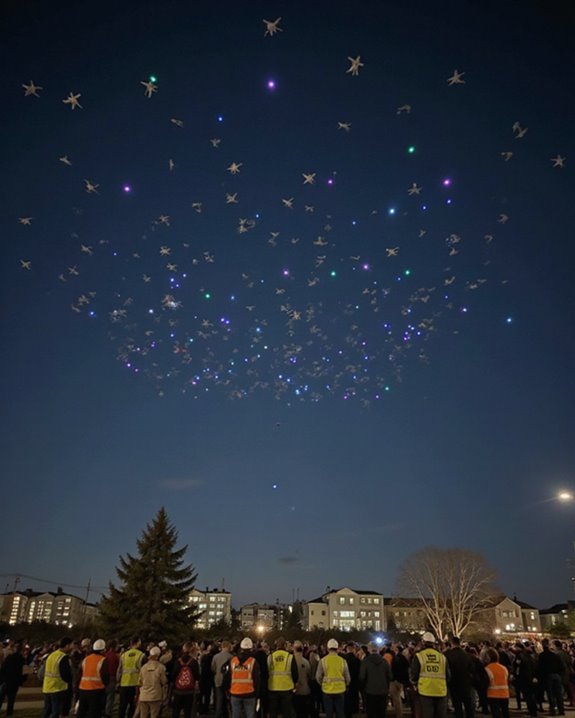
A drone show might look like pure magic from the ground, but behind those swirling lights and synchronized patterns is a serious game of rules, safety checks, and some pretty clever tech! Every show starts with a Risk Assessment—no one wants a drone dropping in on a birthday party uninvited. Legal Hurdles are everywhere: federal aviation regulations mean waivers, height restrictions, and airspace permissions, and pilots must give a heads-up to local authorities. Geofences act like invisible fences, keeping drones far from the audience. Redundant radios, pro-grade equipment, and backup autopilots keep the show running even if something goes wrong. Organizations like the International Drone Show Industry Association work hard to set safety standards. All this effort helps build trust—and guarantees the sky’s the real limit! Additionally, understanding Mission Darkness Recon Shield can provide insight into advanced signal blocking technologies that enhance safety during drone events.
Future Directions for Drone Light Shows
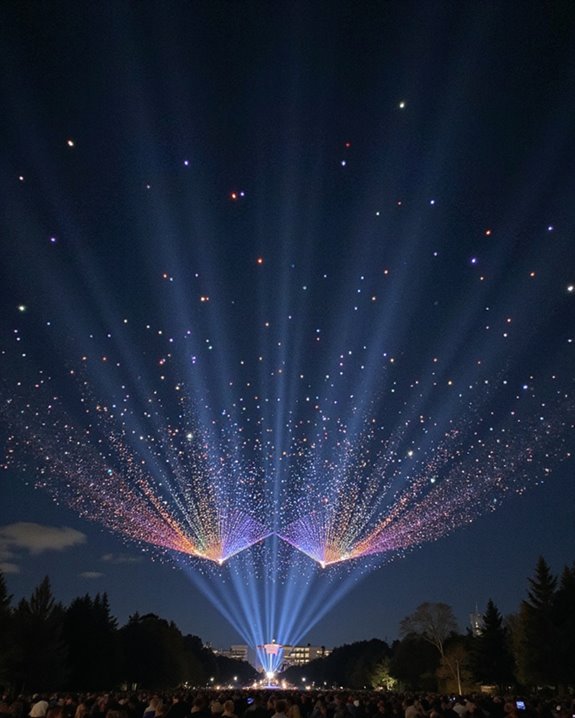
From the ground, all those glowing drones might look like pure science fiction, but the future of drone light shows is shaping up to be even more dazzling than most people realize! Imagine swarms of thousands, guided by AI, dancing across the sky, forming 3D shapes or even your favorite cartoon character. With real-time analytics and advanced sensors, shows will get smarter, safer, and even more interactive. Economic forecasts predict a booming industry, with an 8.2% annual growth rate—so expect drone displays at more than just the Olympics! But there are important ethical implications, like privacy concerns and the impact on wildlife, that can’t be ignored. Still, as hybrid shows mix drones with fireworks and AR, the night sky is becoming the world’s coolest canvas.
Frequently Asked Questions
Who Are Some Notable Companies Specializing in Drone Light Shows Today?
Illuminating the sky like digital brushstrokes, industry pioneers with global presence include Lumasky, UVify, Geoscan, and HighGreat. These companies orchestrate mesmerizing drone light shows, blending artistry and technology for major brands, events, and audiences worldwide.
How Much Does It Cost to Produce a Large-Scale Drone Light Show?
Producing a large-scale drone light show involves significant operational expenses and scalability factors. Costs can exceed $100,000, potentially reaching $1,000,000 or more, depending on the number of drones, complexity, customization, location, and logistical requirements.
Can Individuals Hire Drone Light Shows for Private Events or Weddings?
Individuals can hire drone light shows for private events or weddings. Companies offer extensive personalization options, including custom themes and animations. Legal considerations, such as safety regulations and permits, are typically managed by professional providers to guarantee compliance and safety.
What Environmental Impact Do Drone Light Shows Have Compared to Fireworks?
One might miss the nostalgic smoke and debris, but drone light shows offer a far smaller eco footprint than fireworks. Their minimal wildlife impact, lack of air pollution, and absence of hazardous waste make them surprisingly gentle entertainers.
Are There DIY Kits Available for Creating Small-Scale Drone Light Displays?
DIY kits for small-scale drone light displays are available, offering hobbyists accessible entry points. Kit safety is emphasized through hardware guidelines, while design tutorials on platforms like YouTube assist users in building and programming custom drone formations effectively.


